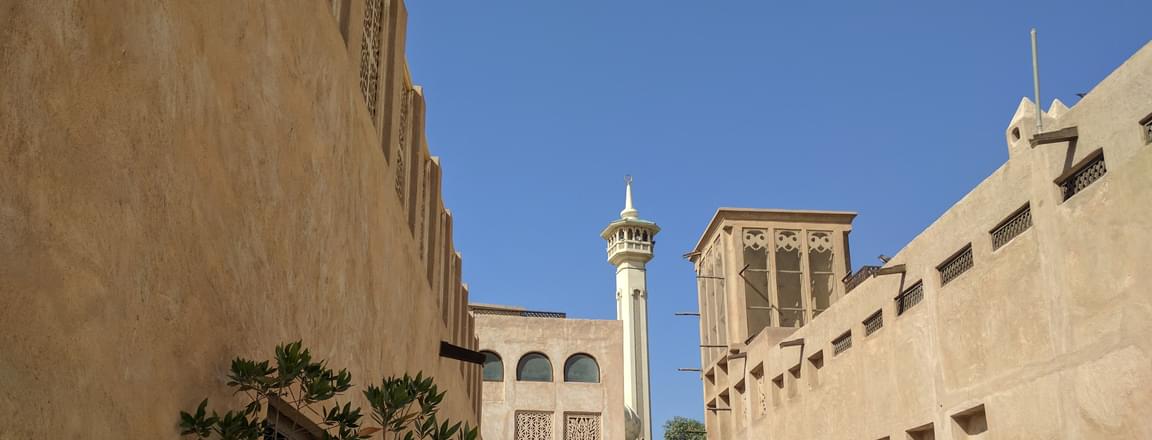
- Home
- Attractions
- Dubai
- Al Fahidi Neighbourhood, Dubai
Al Fahidi Neighbourhood, Dubai

Tucked along Dubai Creek in Bur Dubai, the Al Fahidi Historical Neighbourhood (Al Bastakiya) offers a glimpse into the city’s humble beginnings. Dating back to the mid-19th century, this beautifully preserved area showcases traditional Emirati architecture with wind towers, coral stone houses, and narrow alleys that transport visitors to old Dubai.
Once home to wealthy Persian merchants dealing in textiles and pearls, Al Fahidi today blends heritage and culture through its restored buildings, art galleries, museums, cafés, and cultural centres. A stroll through its winding lanes feels like stepping back in time, offering an authentic contrast to Dubai’s modern skyline. This Al Fahidi travel guide covers everything you need, from top attractions and cultural highlights to visiting tips, to help you experience the charm of old Dubai
About Al Fahidi Historical Neighbourhood, Dubai
The Al Fahidi Historical Neighbourhood is a culturally important area of the city, in its location, and one of the oldest, which is located in Bur Dubai, close to the Dubai Creek. It was constructed in the late 19th century; its design is a blend of traditional Emirati and Persian styles: narrow lanes, wind towers (barjeel), gypsum walls, and courtyard houses adapted to the desert climate.
The space is approximately 3.8 hectares with over 50 redesigned buildings, most of which have been converted into art galleries, museums, cultural foundations, and conventional cafes.
Fun Fact: There is the popular Sheikh Mohammed Centre for Cultural Understanding (SMCCU) that can guide visitors, serve Emirati cuisine, and provide cultural questions and answers sessions that serve to help bridge the global and local knowledge.
Highlights of Al Fahidi Historical Neighbourhood, Dubai
1. Al Fahidi Fort & Dubai Museum: Explore Dubai’s oldest existing structure, housing exhibits that trace the emirate’s transformation from fishing village to global metropolis.
2. Sheikh Mohammed Centre for Cultural Understanding: Join guided tours and traditional Emirati breakfasts that give you a firsthand experience of local culture and hospitality.
3. Coffee Museum: Discover the global history of coffee and enjoy traditional Arabic brews in a cosy, heritage-inspired setting.
4. XVA Art Gallery: One of Dubai’s top contemporary art spaces is housed within a restored courtyard home, featuring regional artists and a boutique hotel.
5. Arabian Tea House: A charming open-air café serving authentic Emirati dishes and refreshing mint tea under white canopies.
6. Dubai Creek Views: End your visit with a stroll along the creek, a view that perfectly connects Dubai’s history and modernity.
Each corner of Al Fahidi offers a unique blend of tradition, artistry, and storytelling, making it a must-visit for history lovers and cultural travellers alike.
Al Fahidi Historical Neighbourhood Details and Nearby Attractions
- Location: Al Fahidi Street, Bur Dubai, Dubai, United Arab Emirates
- Operating Hours: Open daily, 24 hours (some museums and galleries have specific timings)
- Entry Fee: Free (charges may apply for individual attractions like the Dubai Museum)
- Best Visiting Duration: 2–3 hours (half-day recommended)
Nearby Attractions:
- Dubai Creek: Traditional dhow rides and waterfront views.
- Textile Souk: A vibrant bazaar with colourful fabrics, shawls, and local crafts.
- Al Seef District: A modern heritage-inspired promenade with cafés and shops.
- Dubai Museum: Located inside the Al Fahidi Fort.
- Grand Mosque: A short walk away, featuring stunning architecture and one of the tallest minarets in Dubai.
Day-Trip Tip: Combine your visit with Dubai Creek, Textile Souk, and Al Seef for a complete old Dubai experience.
Best Time to Visit Al Fahidi Historical Neighbourhood
- By Metro: Take the Green Line and stop at Al Fahidi Metro Station, just a short 5-minute walk to the neighbourhood.
- By Car: Located in Bur Dubai, easily accessible from Sheikh Zayed Road via Khalid Bin Al Waleed Street. Limited street parking is available.
- By Taxi: Available throughout the city, simply ask for “Al Bastakiya” or “Al Fahidi Historical Neighbourhood.”
- By Abra (Traditional Boat): For a scenic route, take an abra ride from Deira across Dubai Creek to Bur Dubai for just 1 AED.
Al Fahidi Insider Tips
- Join a guided heritage tour for deeper insights into the history and architecture.
- Wear modest, light clothing suitable for cultural areas.
- Visit early to enjoy a quiet atmosphere before tour groups arrive.
- Try a traditional Emirati breakfast at Arabian Tea House or SMCCU.
- Don’t miss the art galleries and photography corners for Instagram-worthy shots.
Al Fahidi Restaurants & Local Experiences
Top Dining Spots Inside or Near Al Fahidi:
- Arabian Tea House Café: Iconic Emirati restaurant offering breakfast, lunch, and refreshing beverages.
- Local House Restaurant: Known for its camel burgers and traditional Emirati meals.
- XVA Café: Artistic atmosphere with vegetarian and fusion dishes.
Cultural Experiences:
- Join Emirati cultural talks at SMCCU.
- Explore local art exhibitions at XVA Gallery.
Attend annual events like Sikka Art and Design Festival, held within the neighbourhood.
Suggested Al Fahidi Itinerary
Morning:
- Start with a walking tour through Al Fahidi lanes.
- Visit the Dubai Museum and Coffee Museum.
- Have breakfast at Arabian Tea House.
Afternoon:
- Join a cultural lunch at SMCCU.
- Explore XVA Art Gallery and nearby souks.
Evening:
- Take an abra across the Creek.
- Dine at Al Seef or nearby heritage cafés.
Why Visit Al Fahidi Historical Neighbourhood, Dubai
- Oldest preserved heritage area in Dubai
- Deep cultural and architectural significance
- Free entry and walkable from the metro
- Beautiful mix of art, culture, and cuisine
- Authentic glimpse into traditional Emirati life
Al Fahidi isn’t just a tourist site, it’s Dubai’s cultural heartbeat, offering a rare opportunity to witness how the city’s story began.
Things to Do at Al Fahidi Historical Neighbourhood
- Walk through narrow wind-tower lanes and courtyards.
- Visit the Dubai Museum for historical exhibits.
- Have traditional tea or lunch at Arabian Tea House.
- Take a guided cultural tour at SMCCU.
- Capture sunset photos near Dubai Creek.
Conclusion: Why Al Fahidi Historical Neighbourhood Is Worth Visiting
As Dubai keeps transforming into an international land of innovation in 2026, the Al Fahidi Historical Neighbourhood creates a reminder of the city and its origins, its history and strength, and its culture. It is not only a historical monument but a breathing history of the Emirati history, their art, and their hospitality. To those who want to travel in a way that is authentic and rich in details (not the skyscrapers of Dubai), Al Fahidi can provide the eternal journey through the times - the walk that unites the past and the present in the most beautiful manner.
FAQs: Al Fahidi Historical Neighbourhood Dubai
Is Al Fahidi free to visit?
Yes, entry is completely free. Certain museums or galleries can charge a small fee.
How much time should I give to explore Al Fahidi?
It is recommended to take about 2-3 hours to tour around without much rush.
Is Al Fahidi a family-friendly location?
Yes, it is a safe place, peaceful, and of all ages.
Are guided tours available at Al Fahidi?
Indeed, there are cultural tours of SMCCU and private tour operators that provide tours every day.
What is the best time to visit Al Fahidi?
November to March in the morning or in the late afternoon.
Update your location?



